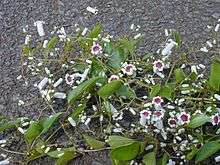Paederia foetida
| Skunkvine | |
|---|---|
 | |
| Scientific classification | |
| Kingdom: | Plantae |
| (unranked): | Angiosperms |
| (unranked): | Eudicots |
| (unranked): | Asterids |
| Order: | Gentianales |
| Family: | Rubiaceae |
| Genus: | Paederia |
| Species: | P. foetida |
| Binomial name | |
| Paederia foetida L. [1] | |
| Synonyms | |
| |
Paederia foetida is a species of plant, with common names that are variations of skunkvine, stinkvine, or Chinese fever vine.[3] It is native to temperate, and tropical Asia; and has become naturalized in the Mascarenes, Melanesia, Polynesia, and the Hawaiian Islands, also found in North America by recent studies.[2]
Paederia foetida is known for the strong, sulphurous odour exuded when its leaves or stems are crushed or bruised. This is because the oil responsible for the smell, and found primarily within the leaves, contains sulphur compounds, including largely dimethyl disulphide.[4]
Distribution
P. foetida is native to Bangladesh and southern Bhutan; Cambodia; Taiwan and China (in Hong Kong and Macau, and the provinces of Anhui, Fujian, Gansu, Guangdong, Guangxi, Hainan, Henan, Hubei, Hunan, Jiangsu, Jiangxi, Shaanxi, Shandong, Shanxi, Sichuan, Xizang, Yunnan, Zhejiang); India (in Andhra Pradesh, Arunachal Pradesh, Assam, Manipur, Meghalaya, Mizoram, Nagaland, Sikkim, Telangana, in the northern part of West Bengal, and the Andaman and Nicobar islands); Indonesia; Japan (in Honshu, Kyushu, Shikoku prefectures, as well as in the Ryukyu Islands); Laos; Malaysia; Myanmar; Nepal; the Philippines; Singapore; South Korea; Thailand; and Vietnam.[2]
Uses
It is sometimes planted as an ornamental; and has virtue in folk medicine.[2] It is also used as a culinary spice in some traditional cooking in North Eastern and Eastern India
References
- ↑ This species was first described botanically and published in Mantissa Plantarum 1: 52. 1767. "Name - Paederia foetida L.". Tropicos. Saint Louis, Missouri: Missouri Botanical Garden. Retrieved August 9, 2010.
- 1 2 3 4 GRIN (October 17, 2001). "Paederia foetida information from NPGS/GRIN". Taxonomy for Plants. National Germplasm Resources Laboratory, Beltsville, Maryland: USDA, ARS, National Genetic Resources Program. Retrieved August 9, 2010.
- ↑ "Ecology of Paederia foetida". ISSG Database. Invasive Species Specialist Group (IUCN and SSC. Retrieved August 9, 2010.
- ↑ K.C.Wong; G.L.Tan (Jan–Feb 1994). "Steam volatile constituents of the aerial parts of Paederia foetida L. (abstract)". Flavour and Fragrance Journal. Universiti Sains Malaysia, Penang, Malaysia: John Wiley & Sons, Inc. 9 (1): 25–28. doi:10.1002/ffj.2730090106.